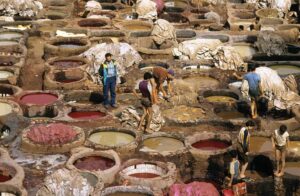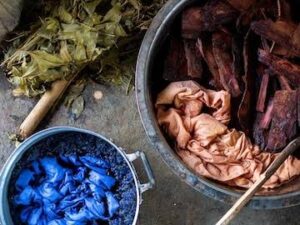Back to: Botany 500 Level
My brilliant Afrilearn botanist, how your side dey?
Today na better day to blend science with culture as we go yarn about something wey your grandma or village craftsmen fit sabi well—Natural Dye Production and Tanning! If you ever see tie-and-dye (adire) cloth or smell that leather sandal for Aba market, you don touch the beauty of this topic. This lesson go open your eye to how plants fit colour our world and preserve materials without wahala from chemicals.
Natural dye production and tanning
Before factory-made colours full market, our people dey use leaves, roots, bark, and even insects to make colours wey fine pass artificial ones. Same thing with tanning—before modern chemicals show, people dey preserve animal skins using local methods so that the leather go last long. These practices no just preserve tradition, dem also protect the environment. Let’s break am down in the most relatable way.

Body – Natural Dye Production
- What Be Natural Dye?
Natural dyes na colours wey come from natural sources—plants, animals, or minerals. Them dey used to colour cloth, hair, body, or even food.
- Unlike chemical dyes, them no cause wahala for the environment and dem dey gentle on skin.
- Popular Nigerian Dye Plants
- Indigofera tinctoria (Indigo) – Na from this leaf we dey get the deep blue used for Yoruba adire.
- Henna (Lawsonia inermis) – Used for body decoration, especially in the North for weddings and Sallah.
- Bixa orellana (Annatto) – Produces reddish-orange dye, used for cloth and sometimes food.
- Hibiscus sabdariffa (Zobo) – Aside from drink, the petals fit give reddish-purple dye.
- How Dye Dey Produced
- The plant part dey soaked or boiled in water.
- After extraction, the cloth or leather dey dipped inside.
- Sometimes, local materials like alum or ash water dey used to fix the dye so e no go wash off quickly (mordants).

Natural Tanning
- Wetin Be Tanning?
Tanning na the method wey dey change raw animal skin to leather wey no go decay. Traditional tanning use plant extracts to do this job. - Plants Used for Traditional Tanning
- Acacia spp. (e.g., Acacia nilotica) – Common for its tannin-rich bark.
- Mangrove bark – Used in coastal areas like Bayelsa and Rivers.
- Sheanut (Vitellaria paradoxa) – Apart from butter, e bark fit help preserve skins.
- How Tanning Happen
- The animal hide dey soaked in water to soften.
- Then e dey dipped in a solution from bark or leaves with high tannin content.
- Over time, the skin change colour, texture, and gain strength.
Why This Matter
- Environmental Safety: Natural methods no pollute water or land like chemical ones.
- Cultural Preservation: These methods be part of our heritage.
- Job Creation: Traditional tanners and dyers still dey feed families across Nigeria.
- Botanical Relevance: You fit study which plants give better results, promote them and even improve farming of such.

Real Life Gist
Picture this: Mama Kudi in Abeokuta dey prepare indigo dye to teach her daughter how to make adire. Or Baba Musa in Kano dey soak goat skins in acacia solution to make leather for sandals. These no be just business—na legacy, passed from generation to generation, all using the power of plants!
Summary:
- Natural dyes and tanning use plant-based materials to colour or preserve items.
- Common dye plants include indigo, henna, hibiscus, and annatto.
- Tanning plants include acacia, mangrove, and sheanut.
- These traditional methods are eco-friendly and deeply cultural.
Evaluation:
- Mention two plants used in natural dyeing in Nigeria.
- What is the purpose of tanning animal hides?
- Why is natural dye production better than chemical methods?
The way you dey carry your brain dey sweet me like ogbono soup with pounded yam! No forget say your knowledge fit revive lost crafts, help local businesses, and even protect our planet. You dey go places, and Afrilearn go dey with you every step. Let’s meet for the next inspiring lesson!
